
Gil Bruvel

David Davis
“Art is made from dreams and visions, and things not known, and least from things that can be said. It comes from the inside of who you are when you face yourself. It is an inner declaration of purpose… David Smith, 1959.
During the Renaissance, pictures were meant to tell stories, usually texts from the Bible or classical mythology. Painted, sculpted, or drawn bodies in those images were made to speak volumes by the way they were arranged.
Artists who followed in their footsteps incorporated the lessons of their antecedents and used many of the same figurative conventions – but with one key difference: over time there was less interest in depicting the external world (or illustrating texts) than in reaching beyond known or visible reality. Instead, new generations of artists chose to examine and express the subtle interior states of the human psyche. Detailed or realistic renderings of the human face and form gave way to more imaginative interpretations, often involving exaggerations in shape and/or color to heighten the emotional impact of the subject.
Case in point visionary artists Gil Bruvel and David Davis, friends with a mentor (Gil)/mentee (David) relationship, who speak the same language about form and its function in their work. The title of their duet at Slate Gray South, up for the month of August, is “Ment(or/ee).
The exhibition underlines the artists’ passion for life, especially for the creative process, which translates experiences, memories, thoughts and feelings into tangible beauty and underlines the double function of their work (and sculptors like them): to recognize a worldly identity, as well as the endless surprises that emerge from active inner lives.
“Ment(or/ee).officially opens with Art Walk on August 4 (with an artist’s talk at 4 pm.)
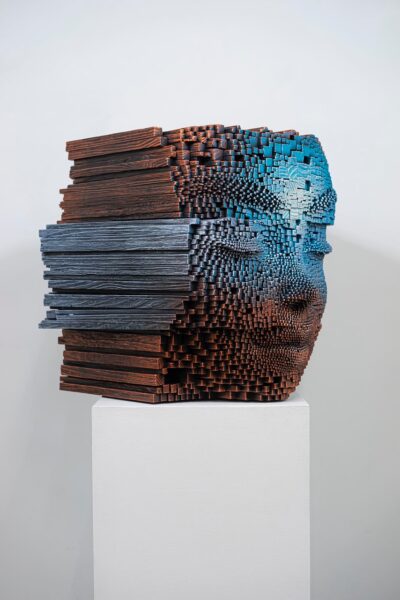
Image, Gil Bruvel
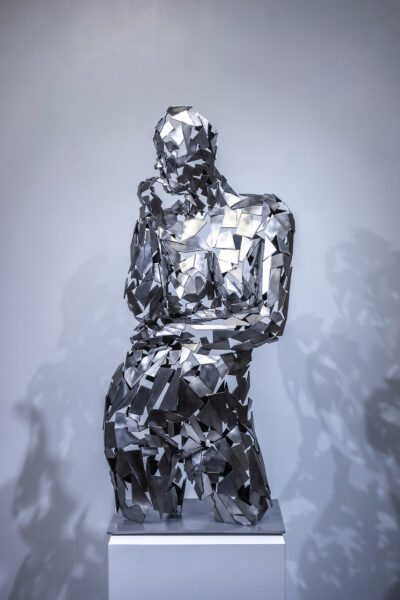
Contemplation, David Davis
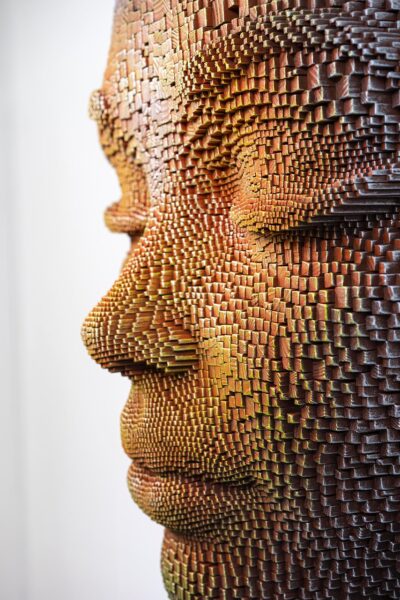
Bruvel
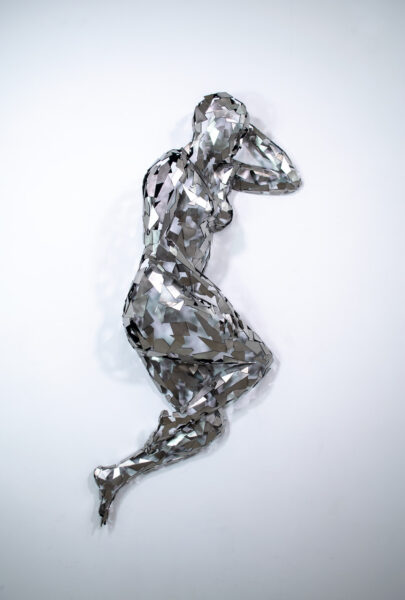
Immersed 1, Davis
Quoting a recent article about Gil’s work:
“…Bruvel presents a series of meditating faces, sculpted from wood he calls ‘burn sticks.’ This involves a ritual process of building up layered profiles, bringing the assemblage together sculpturally, and then burning the wood…Additional surface treatment leaves the wood’s veins accentuated, the alchemy of the process serving as a reminder that we are all organic, ephemeral beings with a limited time in which to act…”
“Bruvel speaks of our deep human history with wood, how trees adapt and survive, and how we have likewise adapted and survived through their use as a primary tool and material…
“…The pixelated outlines mimic our complex neural pathways, while his use of gradient color reinforces interconnectedness.”
“I would say as an overall view for my Masks/Pixelated Form Series, it is a representation of an inner life that is expressed via the meditative heads or faces, and the colors are more of a representation of various emotional states,” explains Gil. “Since an early age color for me were an expression of emotions, states of mind and feelings, down to equating colors to sounds. We can see in the animal world the pulsating/changing colors used by different animals to either camouflage or signaling something to the outside world.
“For the stand-alone pieces typically the back of the sculpture/behind the head, I create an abstract pattern representing a neural network that symbolize our life experiences, emotions, sensations and feelings etc. at any given time…
Quoting the show’s curator, gallery director Krissy Kula:
“…David Davis forged his artistic career with fire, welding hundreds of pieces of steel into beautifully posed forms for his ‘Reflections’ series. A long-standing passion for figurative arts was the driving force behind the work which began almost four years ago. Each figure starts with the subject striking a pose. Davis then photographs and sketches the model, measures every inch of the body, and finally welds the pieces together shard by shard to recreate the model to scale…Many of his subjects are holding yoga poses, are deep in a meditative state, or taking time for reflection – embodying ideas of physical, mental, and spiritual self-betterment.”
“I suppose I see abstraction in everything in that everything can be questioned conceptually by various perspectives,” adds David. “So I feel that my work exists as a bridge between how we see ourselves as individual entities and the concepts that drive us and allow us to flourish. The fragmentation allows the forms to exist as we do, as our ideas do, in various facets, forever changing in relation to the perspective taken. We do not exist as a singular represented idea…”
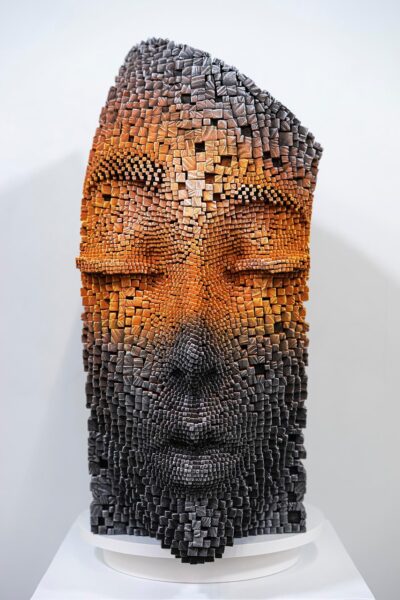
Bruvel
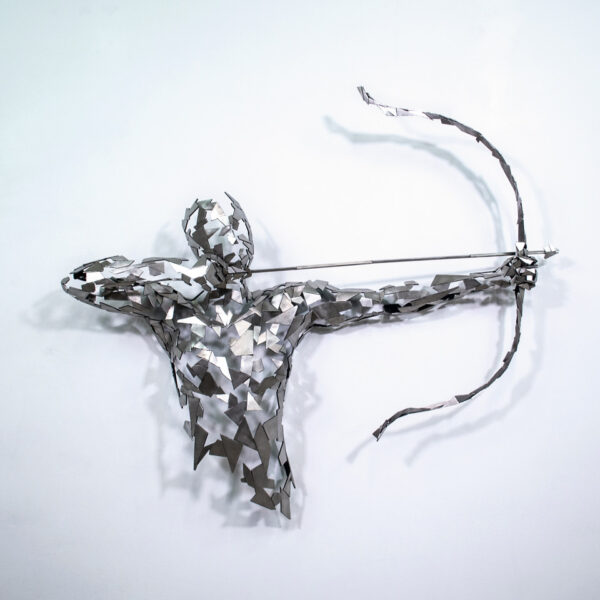
Steadfast 1, Davis

Bruvel
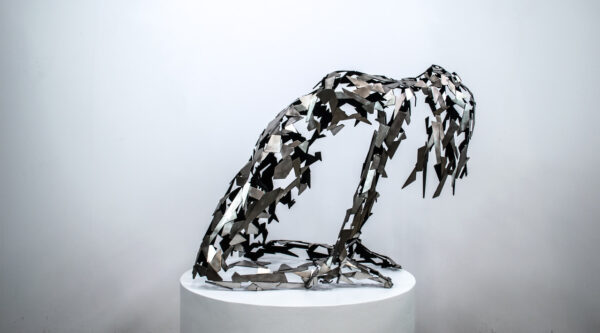
Utrasana 5, Davis
About the mentor/mentee relationship:
TIO to Gil: Please talk about your relationship with David Davis. What do you think he learned from him and you from him when he was your assistant?
David taught me to be more patient with my assistants 😊. Being surrounded by younger creative minds brings new perspectives, also feedback critiquing some of my artwork in progress. But there is more to it: David helps me remember my path as I started at a very young age.
What I see overall with a very talented artist like David coming out of a university art program is the lack of teaching about how to be sustained by their art, how to thrive. Apparently that is not part of art curriculums at universities. It could be very discouraging for a young artist to go out into the real world armed with an art degree and not understand, for not having been taught, how things work. So, I would say David has learned very well with his hard work to put himself out there and that has given him the financial means to continue to develop his creativity and produce great sculptures… So many talents get lost without proper guidance.
TIO to David: What lessons did you learn from Gil and what do you think Gil learned from you?
Working with Gil has taught me exponentially more than I ever expected. The university environment was great at teaching foundational concepts and learning to use some tools required to be an artist, but the real-world application of a career as an artist is something you can only get from, well, the real world. The art world is diverse in its needs, but it is still a world of business. Communicating with galleries and collectors, creating consistent series of works, financial aspects, as well as the more subjective notions of the artist life, that can only come from a true artist/life perspective.
As for what I’ve taught him – I do believe having other creative minds around is an amazing way to inspire new concepts, as well as better ways of working and/or creating. I would hope a fresh set of eyes has helped Gil troubleshoot issues, be they conceptual or in the process of construction. I also believe my background in metallurgy has been of some benefit to have around.
Gil Bruvel, Q & A:
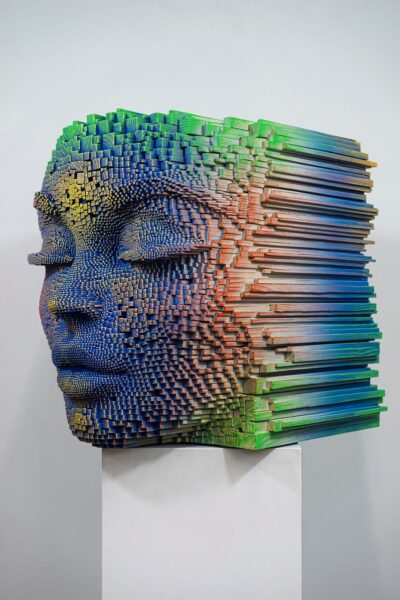
Gil Bruvel – Emma (3)
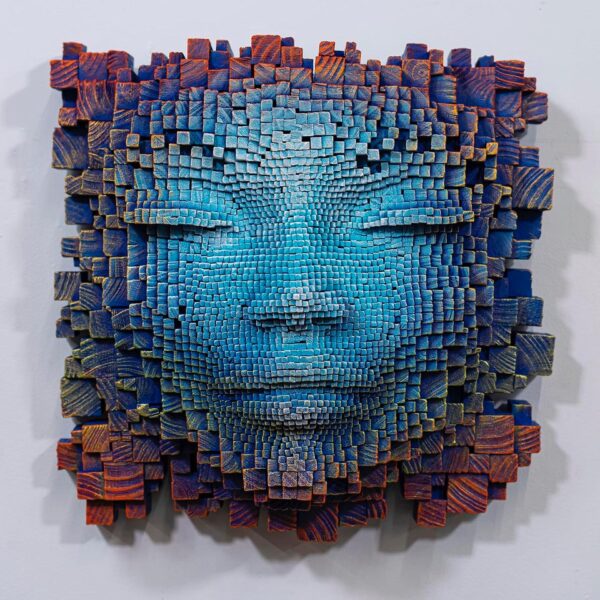
Mask 205
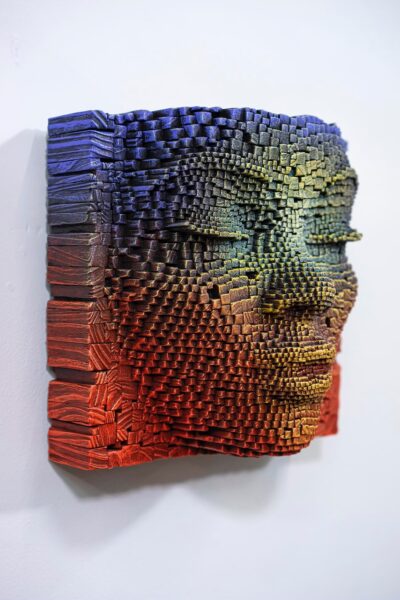
TIO: What inspired you to create portraits using thousands of burnt wooden sticks?
Wood is a great medium to play with, one aspect of it is its growth that is visible through its rings and endures sometimes across some extremely long periods of time. I felt that using thousands of wood sticks to form these meditative faces with a medium like wood would create a parallel expressing our own evolution through time; each stick would express the multi facets of the human nature and condition.
TIO: Though distinct and different, your 3D portraits all share a certain bodhisattva-like serenity. Since I assume no accidents in your art, that must be intentional. Are you representing individuals – like yourself? – whose goal is awakening to their true, unchanging Self, not the self we generally experience in the world of name and form?
We are probably accustomed to associate Indian or Asian with these meditative sculptures from different periods/centuries and it would be natural to identify my meditative faces with these cultures. That is certainly not intentional. I work mostly from imagination, but I also spend a lot of time studying the facial features of different ethnicities. I feel that because we live in such a global world, having access to so much information and connections to many other cultures, it is important for me to represent the incredible diversity of morphologies to underline different aspects of humanity within my work. The pursuit of happiness is without geographical boundaries and my new work attempts to express that.
TIO: Please describe your “burn sticks” process.
The burnt stick process or SHOU SUGI BAN originated in Japan in the 18th century. Shou sugi ban is a particularly striking method of preserving wood by charring it with fire. Traditionally, this practice is done using Japanese cedar in order to weatherproof it: the wood is burned until the surface is charred, then coated with natural oil. The difference is that I am brushing the charred wood afterward to reveal the relief of the veins of the wood, then I paint it.
TIO. Your earliest influences included your father, a renowned cabinetmaker, then some of the Surrealist super novas like Dali, Max Ernst and de Chirico, and later Robert Matta and Francis Bacon, whose challenging work attracts extremes of high praise and calumniation. Later on, you cite Zaha Hadid, whose trademark included fragmented geometries. Frank Gehry too. His art reflected his concern with inventive forms made from unexpected materials. Please talk about how those influences show up in your art which has taken many forms beyond the burned sticks: painting, graphite pencil, bronze-casting, functional furniture, public sculpture, and works in stainless steel.
Using several different mediums to express myself corresponds to a genuine curiosity about human nature and nature itself. Some of these early influences made me realize how important it is for an artist to have access to the different mediums, different materials and/or techniques employed for sculpture or painting to name the more traditional. For example, the overwhelming diversity of mixed-media materials to paint, design or sculpt, down to using new technologies to create new forms of art.
Each medium inspires different forms of expression, the more fluency and knowledge one has with these different tools and materials the wider is the inspiration to keep pushing the limits of creativity.
TIO: On your website you have a pull down that points to your NFTs. How do non fungible tokens fit into the big picture of your art story?
It doesn’t right now, I am just following the trend in case it becomes a viable mean of expression, when thing settle down and great artwork starts to come out with some true new and innovative ideas and mediums.
David Davis, Q & A:
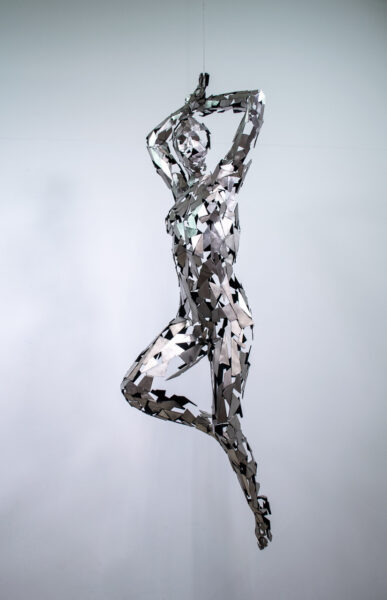
Ambedo 2
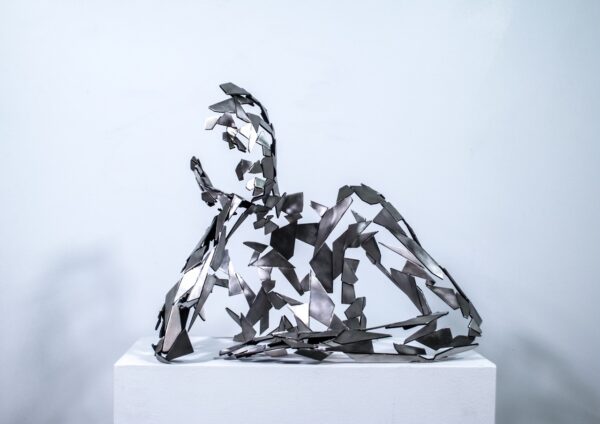
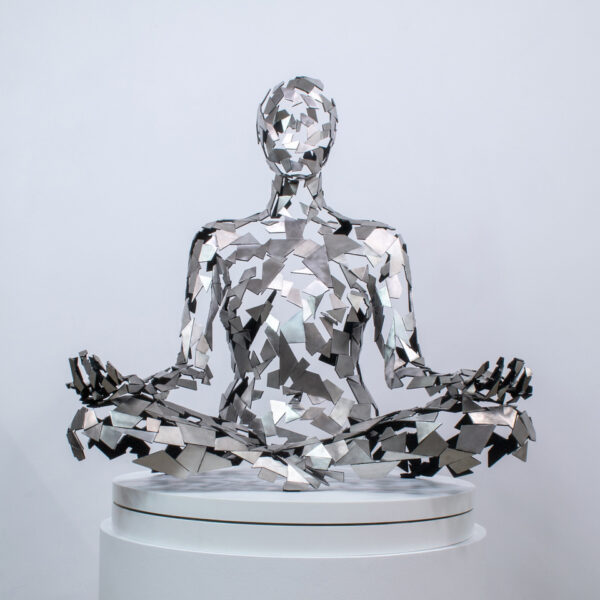
Clarity 1, Davis
TIO: Please share something about your backstory, your personal history? What in your early years set you on the path to becoming an obsessive creator?
I believe growing up in a photography studio had a strong impact on my path. From an early age, I consistently witnessed, and was a part of, the capture and creation of beautiful moments found throughout people, culture, and place. Growing up my parents would have me help with projects in and out of the studio, instilling the notion that creation takes effort, hard work, and a keen eye, as well as a grasp of manipulating the materials this world provides. When I wasn’t helping around the studio, I would spend my time sculpting clay and drawing which allowed me to create my own “photographs” of what stood out to me in life. The idea of creating a completely new question, idea, or simple object from altering that which was around me has always fascinating and fuels my art to this day.
TIO: Who were your earliest artistic influences?
At a very young age I would say my parents were my primary artistic influences, as I would watch them create on an almost daily basis. As I grew and became exposed to more historical artistic culture, I found a love for the mythological Renaissance painters such as Bosch and Botticelli. The conceptual visions of their works brought the stories such life, made the stories seem real, and I was fascinated by that ability to create an entire reality from a precise combination of simple pigments and wood.
TIO: Why the fragmentation, a technique you share with Gil Bruvel whom you once worked for in his studio as an assistant/shop manager. Why all that negative space?
I feel the fragmentation allows the form to exist as we do, as our ideas do, in various facets, forever changing based on a chosen perspective. We do not exist as a singular represented idea, we are a forever evolving collection of experiences, ideas, memories, and emotions. As for what could be described as negative space in my work, I look to the concept that you cannot have a wave in water without both a crest and a trough. As in life, a perspective, emotion, or intent cannot exist without the lack of another or in this case – “space.”
TIO: What do you hope your viewers will take away from your dance with Gil Bruvel at Slate Gray?
Well, I feel its always the role of an artist to create questions, so I would hope as many viewers as possible leave with an even more inquisitive mindset which, of course, leads to knowledge, evolution, and self-betterment.
Written By



